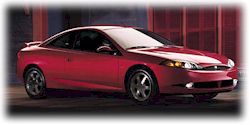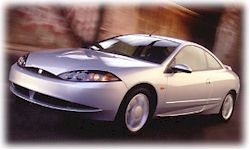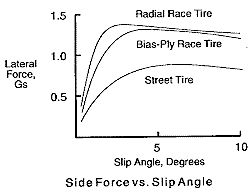Rumors & Gossip
Note: I disclaim all responsibility
for accuracy of the info contained herein.
|
Notes:
April, 1999
We’re not racing Spec Racers any more, so we’re kind of “out of the
loop”. I refer you to Mike Steele’s Page (http://www.specracer.com/) for the
latest SRF skinny. |
|
The Next Thing
For the 1999 season, the Mumm Brothers team will be
campaigning in SCCA’s “World Challenge” Series. We’ll be running
Mercury Cougars. Nice looking cars!
 |
The Cougar is a “New Edge” design -- based on the Mondeo platform. |
|
 |
We'll be running a 2.5 liter, “Duratec” V6 powered car. |
|
Notes: August, 1998
From the Pro Race at Watkins Glen.Substantive Stuff
We are still running our first set of BFG’s. They are as fast or faster than
new tires. The undertread on the tires is clearly sufficient to last a long time.
I’d estimate 5 to 6 race weekends on a set with no drop off with number of heat
cycles. |
|
Notes:
August, 1998
From the Pro Race at Pikes Peak.Substantive Stuff
From the “For What It’s Worth” department: The Oval setup seemed to
us to be -- positive camber on the inside tires, slightly more negative on the outside,
about 2 degrees of caster lead (more positive front caster on the right side) and full
soft on the rear bar. We tried lots of tire pressure combinations, but came back to
our standard setup.
We developed a terrible miss in the car during the race...and twice during the weekend we
had vapor lock problems. Vapor lock at the fuel pump. We had to put cold water
on the fuel pumps to get the cars running again after a vapor lock problem during an
extended practice. I think this has something to do with the local fuel. I
didn’t have a Reid Vapor Pressure tester so I can’t tell you much about the
fuel. |
|
Notes: June 26-28, 1998
From the June Sprints at Road America.Substantive Stuff: During
post-qualifying inspections, a high-buck Snap-On exhaust emissions analyzer was used to
“sniff” the exhausts of most of the field. Naturally, our car was one of
the few that didn’t fall into a common emission range (high idle CO). We
started hunting down the reason. Here’s what we found:
The car passed the normal KOER (key on, engine running) Star test (it gave us the
“111” code). But on the subsequent cylinder balance test, the diagnostic
reading produced a “90”. “90” means “Cylinder #4 Low”.
We changed the fuel rail with injectors (thanks to John Versey for the loan of the
fuel rail, by the way) and the car now passed the cylinder balance test. Our belief
is that the injector in cylinder #4 was leaking fuel, and that when the Star tester turned
off the #4 injector, fuel continued to flow (This was substantiated by listening to the
engine sounds during the test. Number four cylinder didn’t miss as badly as the
others when the injector was turned off.). The high idle CO reading was caused by
excess fuel in #4 cylinder due to this leaking injector. Bottom line, it probably
would be good to run a cylinder balance test now-and-then to ID flaky injectors. |
|
Notes: June
12-13, 1998
From the Pro Race at Mid-Ohio.Substantive Stuff: Thing #1:
Check the routing of your oil lines and battery cables. We had a DNF at Mid-Ohio
after the crankshaft pulley wore through one of the oil lines. DUMB on our
part...and expensive...no prize $ and a $100 “Start-Lite” hose shot.
Thing #2: Starting to dial in the BFG’s. Most guys are now running more
camber. We’ve been raising tire pressure and it seems to help. It’s
also clear to me that we’ll be able to get at least 3 race weekends on the tires
before they’re worn out....and maybe more. Tire performance appears to improve
(or at least stay the same) over time.
Thing #3: John Bowden had another one of those weird intermittent high speed miss deals on
Stevie Ray’s car. The miss went away after he changed the battery, alternator
and master switch (he’d already changed the EDIS, relays, fuel rail and
injectors,plugs, and plug wires). I’m becoming increasingly suspicious of flaky
alternators. |
|
Notes: May
16-17, 1998
From the Pro Race at Heartland Park Topeka.Substantive Stuff: The differences
in setups on the BFG’s between the front runners was amazing. Some guys had big
camber, some small. Both seemed fast. Over time we’ll figure out what is
optimum. A couple of things seem clear, however. First, proper break-in seems
pretty important. There is a big difference between scrubbed-in tires and new
tires. Second, based on the total number of spins and “sideways events” by
all the cars, the coefficient of friction vs. slip angle curve of the BFG is clearly
steeper than the Yokohama.
 Referring to the graph on the right, if you imagine the
curve of the Yokohama being the one labeled “Street Tire” and the BFG the one
labeled “Radial Race Tire” you’ll get the picture. The only
difference from the graph is that it appears that the Yokohama has slightly more overall
total grip...that is that the “Street Tire” curve would be higher on the graph
than the “Radial Race Tire”/BFG curve. The bottom line: when you go past
the “limit”, it’s more likely you could “save” a Yokohama tired
car...the value of precise driving has just gone up. Referring to the graph on the right, if you imagine the
curve of the Yokohama being the one labeled “Street Tire” and the BFG the one
labeled “Radial Race Tire” you’ll get the picture. The only
difference from the graph is that it appears that the Yokohama has slightly more overall
total grip...that is that the “Street Tire” curve would be higher on the graph
than the “Radial Race Tire”/BFG curve. The bottom line: when you go past
the “limit”, it’s more likely you could “save” a Yokohama tired
car...the value of precise driving has just gone up.
|
|
Gossip as
of May 10, 1998
Comments from test day at Blackhawk, May 2, 1998.
Substantive Stuff: We didn’t learn too much. Just
scrubbing in BFG’s in preparation for the first Pro Race at Heartland Park May
15th. Only interesting technical note was Jim Marinangel’s mysterious miss.
The prior weekend Jim had replaced the voltage regulator on his alternator.
Everything worked fine in the subsequent race. During qualifying this weekend, the
car developed a terrible miss. After much chasing, the culprit was found to be that
very same regulator. Lesson: Whatever you changed last is most likely the
cause of any problem. |
| Rev.
2/8/99 |


 Referring to the graph on the right, if you imagine the
curve of the Yokohama being the one labeled “Street Tire” and the BFG the one
labeled “Radial Race Tire” you’ll get the picture. The only
difference from the graph is that it appears that the Yokohama has slightly more overall
total grip...that is that the “Street Tire” curve would be higher on the graph
than the “Radial Race Tire”/BFG curve. The bottom line: when you go past
the “limit”, it’s more likely you could “save” a Yokohama tired
car...the value of precise driving has just gone up.
Referring to the graph on the right, if you imagine the
curve of the Yokohama being the one labeled “Street Tire” and the BFG the one
labeled “Radial Race Tire” you’ll get the picture. The only
difference from the graph is that it appears that the Yokohama has slightly more overall
total grip...that is that the “Street Tire” curve would be higher on the graph
than the “Radial Race Tire”/BFG curve. The bottom line: when you go past
the “limit”, it’s more likely you could “save” a Yokohama tired
car...the value of precise driving has just gone up.